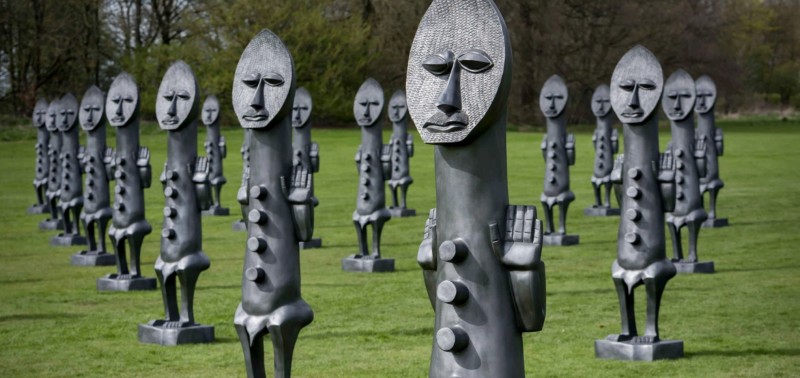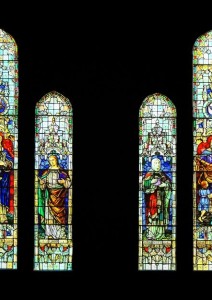Art and money: How modern patrons are facilitating long-term value exchange
Andy Warhol’s 'Shot Sage Blue Marilyn' sold for a record-breaking £158 million at auction this week, a shining example of art colliding with capitalism. While the relationship between art and money is sometimes a strained one, art plays a significant role in the investment world; its continued emergence as a meaningful alternative asset class has meant that the relationship grows ever more complex. However, with considered and responsible ownership, modern patrons can support long-term value creation for artists and custodians alike.
Taking a break during the recent vernissage of The 59th Venice Biennale, the art world’s marquee event, which, though non-commercial is buoyed by powerful undercurrents of patronage, curator and art adviser Nick Hackworth sat down to interview collector and financier Hussam Otaibi about the livewire topic of art and money.
NH: Hussam, personally you are a collector and founder of a significant private collection and professionally, you are a financier whose investments include artworks. Would you say you identify with one role more than the other?
HO: First and foremost, one has to be passionate about anything one does. I certainly try to live by this maxim. The answer is I am passionate both about being a patron of the arts, supporting culture for its own sake, and, when I do so, investing in art in the right way. I founded Modern Forms both as a collection and as a platform to support carefully selected artists and cultural initiatives. We are living in an era where cultural dialogue is more vital than ever and I am proud to contribute to it. Modern Forms is about passion, not profit.
Alongside that, I am a huge advocate of art being considered an important asset class. For the past decade or so, I have, together with friends and clients who enjoy collecting, acquired significant artworks with a view that they will appreciate in value over the next 10-20 years.
This is absolutely not about buying and flipping art for short-term profit, but about respecting and being a responsible custodian of the work you invest in. In fact, Shanti (a subsidiary of one of the funds Floreat advises on) is significantly invested in art. Shanti’s collection today includes pieces from major artists like Jenny Saville, Damian Hirst, and Tracey Emin, as well as selected emerging artists, like Harold Ancart.
It’s about working to safeguard, and in some cases increase, the significance and value of the work.
Hussam OtaibiNH: Art has emerged as a recognised asset class over recent years. What advice do you have for those considering art as part of their investment portfolio?
HO: The best advice is that one should be extremely cautious when investing in art. Firstly, it is a highly specialised field: one really needs to understand the dynamics of long-term value creation and be able to distinguish significant fundamentals from the hype that characterises the market.
Secondly, I would reiterate that responsible art investing needs to be approached as a long-term endeavour. I’m talking about having a 10-20 year investment horizon, if not more. I think ‘flipping’ or a very short-term attitude, especially when executed with the work of emerging or mid-career artists, can be very damaging to those artists in the long term.
The focus should always be on a win-win scenario for both the artist and the patron of the work.
Hussam OtaibiNH: If you look at the collecting landscape, what examples would you pick out of collections that successfully marry investing in art with responsible, or even exemplary, custodianship of those artworks?
HO: I think there are many corporate collections that do just that. Staying within the finance sector, you have groups like Deutsche Bank and Pictet that have sophisticated and committed collections and art programmes, which reflect their corporate cultures in different ways. I find the fact that finance companies can so sincerely and successfully engage with contemporary art quite inspiring.
NH: What’s your position on the apparent ever-increasing power of the mega-galleries? Love them or loathe them?
HO: Despite all the changes the art market is undergoing, especially the accelerated digitisation of the art world during the pandemic, the gallery system remains the backbone in the field. The mega-galleries do get a lot of flak for being overly dominant. It is certainly true that the primary art market is structured to favour first-movers and incumbents because they can cherry-pick all the best talent as it rises through the ranks.
However, when you look at the quality of what is done by Hauser & Wirth, David Zwirner, Gagosian, Thaddaeus Ropac and the like, it's almost uniformly impressive, both creatively and commercially. I think they deserve their success and, if in their expansion they also grow the market, then I think that should be celebrated.
One of the reasons I think these galleries are so successful is that they are led by people, be they the founders or senior directors, who are truly passionate about what they do. As I said before, it is all about loving and having a passion for what you do, and wanting to be of service to the medium.
I was recently reading The Inner Mirror, a semi-autobiographical work by Ursula Hauser. What truly shines through is her deep love of art and artists; that love came first, long before she founded the gallery. Despite being a huge, international operation I think you can still sense that authenticity and passion when you go into a Hauser & Wirth gallery, which is remarkable. That sense of authenticity and passion is always what I look for in terms of my relationships with galleries.
On a smaller scale, one of my favourites is Vigo Gallery in London. Founder Toby Clarke has an amazing passion for art and, in my view, he is a collector and art fan first and a gallerist second. That love gives him the drive to promote the art he represents so well.
Another gallery that champions emerging talent is The Sunday Painter, also in London. They’ve been going for a while now and they have always drawn their own path; they sometimes take creative risks, but that comes from a deep passion for what they do.
NH: On galleries, a growing number seem to be acquiring real estate to showcase outdoor sculpture, along with collectors and sometimes even artists. In your view, are they making art or real estate investments?
HO: Often in these cases, it is both. Hauser & Wirth’s new post in Menorca, for example, will of course attract new collectors and art lovers to the island, which will create jobs, increase real estate values, and help the local economy.
Even governments are realising just how powerful art can be as a promotional tool and are following this model. I’m thinking of Al-Ula in Saudi in this case, where the Desert X Art Festival is one of the main resources being used to build awareness of the area and the country. To this day it is one of the most impressive projects of that kind that I have seen.
Art can be a very powerful tool to create value on multiple levels if it is deployed in a responsible way.
Hussam OtaibiIn 2014, one of the funds that we advise at Floreat and one that we are investors in, acquired Springs Farm, a country estate in England. We created a joint venture to develop the estate into a state-of-the-art equestrian facility and a sculpture park. Today the land is home to a significant display of outdoor sculptures from the Modern Forms collection.
The Invisible Men by Zak Ové, a major outdoor installation we acquired in 2016, which was on loan for two years to the Yorkshire Sculpture Park, is now exhibited at Springs Farm. We also have significant works by Marguerite Humeau, Charles Harlan and Douglas White on show there.
Art will help promote the estate and increase its value over the long term, and at the same time, the estate acts as a showcase for the artists’ work. I think that’s an exemplary, mutually beneficial set-up – a win-win.
Some of the inspiration for what we’re doing has come from several visits to The Venet Foundation in Le Muy, France. It was set up by the great artist Bernar Venet, who has become a dear friend over the years. Bernar has created such a wonderful and elegant environment to showcase not only his extraordinary works but also his truly astonishing collection of minimalist masterpieces. Another inspirational site is Gibbs Farm, in North Auckland, New Zealand. To be able to place monumental works like those in such majestic landscapes is a dream.
NH: Do you think that more funds will be created to invest in art?
HO: I hope so. A steady influx of more responsible investors and collectors into the art world would benefit the industry in all sorts of ways. I still remember when the Fine Art Fund was created, around 20 years ago now, that there was quite a bit of resistance from the art world, which I find interesting.
Of course, the underlying factor of this discussion is the contradictory and ambivalent relationship the art world has with money, notwithstanding some of its more commercial elements.
Anyway, the fact that the fund has been managed in a responsible and respectful way has, I believe, won many people over and paved the way for other professionally-run funds. My wider point is that the art market has space for everyone – from collectors, galleries and investors to artists, who should always benefit from their work, even when the work is re-sold multiple times.
Hussam Otaibi is the founder of Floreat and Modern Forms. Nick Hackworth is a curator and writer, and is curator of Modern Forms.
Images:
Top: Andy Warhol, 'Dollars', available to use under Creative Commons (license information)
Gallery 1: Samara Scott, 'Still Life III' (2014). Courtesy of the artist and The Sunday Painter
Gallery 2: Zak Ové, 'The Invisible Man' (2016-17). Courtesy of the artist, Modern Forms, Vigo Gallery and YSP
Gallery 3: Charles Harlan, 'Concrete' (2014)




